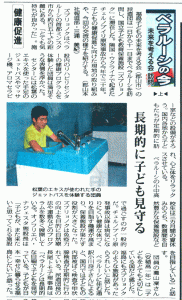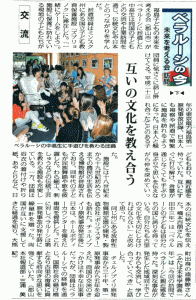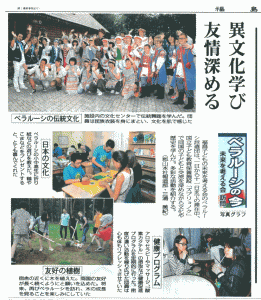Original Japanese written by staffer
The English below written and arranged by Heeday, based on the original Japanese
The English edited by Rev. Dr. Henry French, ELCA
Below: Articles from the August 13th, 14th, and 15th, 2016 editions of the Fukushima Minpo newspaper
Fukushima being rebuilt, yet not restored
5 and 1/2 years after the devastating earthquake and the nuclear power plant (NPP) disaster of March 2011, no-go restrictions have been lifted for one district after another. Thus, recovery seems to be in rapid progress—until you see that most residents here live with the fear of radiation. Especially important and urgent is the care of children living here, whose precious childhoods have been ruined by radiation.
A new move
Now, some groups in Fukushima have visited Chernobyl. Their intentions? To learn the experiences and knowledge acquired since the 1986 disaster, and to see what is happening today in those areas contaminated with radiation.
To Belarus
One such visiting group, “Fukushima Kodomo no Mirai wo Kasngaeru Kai” (Fukushima Association for the Children’s Future), runs fellowship programs in cultural and athletic activities for secondary students in Fukushima and children in Belarus. The participants from Fukushima stay in camping facilities or elsewhere in Minsk, the capital of Belarus. During the summer school holidays this year, a group of Fukushima children spent 10 days at a state-run facility for children’s education and recuperation. Following the Chernobyl disaster in Belarus, the national government established recuperation facilities The nation has 14 such facilities, and affected children can choose to utilize any of them. The facilities are free of charge for children up to high school age living in the contaminated areas.
The facility the Fukushima children visited has an abundance of equipment, ranging from jet baths that treat arms and legs with an extract from pine leaves, to massage machines, to aroma therapy rooms. The children visiting from Fukushima happily used them to refresh themselves, both mentally and physically. The facility also includes a museum of farmers’ lifestyles from the end of the 18th century through the early 19th. In addition, there are classrooms for making craftworks of straws, embroidery, and etc. Thus, this facility is a great place where Belarussian children can learn their own traditions and culture. Clearly they are proud of their cultural heritage. Seeing their pride, Fukushima children are now more eager to learn their own cultural heritage.
The Japanese author’s wish
Ever since the Fukushima Daiichi meltdown began, many organizations have been running temporary retreat programs which take Fukushima children to places with less radiation so they can regain their health during, for instance, their summer school holidays. We, the No Nuke Project of the Anglican-Episcopal Church in Japan, have been holding such retreat programs as well. The children play as they want to outdoors in places with less radiation and look so delightful and full of energy – proof that such programs are truly helpful. I hope we will soon see facilities like the ones in Belarus, as well as more integrated programs, available for all the children growing up here in Fukushima.



